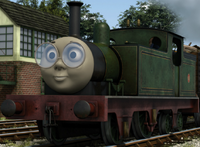Although I'm not really into the Thomas and Friends series anymore as a whole, due to being grown up, I still have happy memories of when I was still into the series. And I still like the engine prototypes the characters are based on.
But anyway, here's a list of some of the engine characters from Thomas and Friends, their basis's, when they were built, and how fast they have been reported to go.
List of Engines and their Top Speeds[]
| Character: | Class: | Built: | Configuration: | Top Speed: |
|---|---|---|---|---|
| Edward | Furness Railway 21/K2 Class 'Larger Seagull', with square cab lookouts, cab windows, a fowler tender, and no coupling rod arches | 1896 | 4-4-0 | 70–80 miles per hour / 112.5–129 kilometres per hour[1] |
| Gordon | Great Northern Railway Gresley Class A1 Pacific, with a fowler tender | 1920 or 1921, rebuilt 1939[2] | 4-6-2 | 100–105 miles per hour / 161–169 kilometres per hour[3], 120 miles per hour / 190 kilometres per hour (streamlined form) |
| Henry | London, Midland and Scottish Railway Stanier 'Black Five' Class 4-6-0, with a one window cab, wheel arches, and a blocky tender; originally London and North Eastern Railway Gresley Class A1 prototype | 1919, rebuilt 1935 | 4-6-0, originally 4-6-2 | 96 miles per hour / 155 kilometres per hour (rebuild) |
| George Hughes[4] | Lancashire and Yorkshire Railway Class 28, with a pony truck, a belpaire firebox, a fowler tender, and front sandboxes mounted underneath his footplate instead of joined to his leading arches | 1912 | 2-6-0, originally 0-6-0 | 70–80 miles per hour / 112.5–129 kilometres per hour[5] |
| Thomas | London, Brighton and South Coast Railway E2 Class, with extended side tanks, an extra window on the sides of his cab, and wheel arches | Between June and September 1915, rebuilt 1960 | 0-6-0T | 30–70 miles per hour / 48–113 kilometres per hour[6] |
| James | Lancashire and Yorkshire Railway Class 28, with a pony truck, a belpaire firebox, a fowler tender, and front sandboxes mounted underneath his footplate instead of joined to his leading arches | 1912 or 1913 | 2-6-0, originally 0-6-0 | 70–80 miles per hour / 112.5–129 kilometres per hour[7] |
| Percy | Avonside 0-4-0ST, with Hunslet underframes and valve gear, a smokebox protruding from his saddle tank, external cylinders and motion, and sandboxes underneath the tanks on his footplate | circa. 1897, rebuilt circa. 1935 | 0-4-0ST | 35–45 miles per hour / 56–72.5 kilometres per hour[8] |
| Toby | Great Eastern Railway Class C53 0-6-0T | 30th June 1914 | 0-6-0T | 20–45 miles per hour / 32–72 kilometres per hour[9] |
| Skarloey | Fletcher Jennings Class C 'Talyllyn' | 1864, rebuilt 1866 or 1867, 1952–1958, and 1985 | 0-4-2ST, originally 0-4-0ST | 20–35 miles per hour / 32–56 kilometres per hour[10] |
| Rheneas | Fletcher Jennings Class Bb 'Dolgoch' | 1865, rebuilt 1952–1961[11] | 0-4-0WT | 20–35 miles per hour / 32–56 kilometres per hour[12] |
| Sir Handel | Hughes Falcon 0-4-2ST Class No. 3 'Sir Haydn' | 1904, rebuilt 1910 and 1960[13] | 0-4-2ST, originally 0-4-0ST | 25–30 miles per hour[14] / 48 kilometres per hour |
| Peter Sam | Kerr Stuart Tattoo Class No. 4 'Edward Thomas' | 1920, rebuilt 1961[15] | 0-4-2ST | 25–30 miles per hour[16] / 48 kilometres per hour |
| Duck | Great Western Railway 5700/57xx Class | 31st March 1929 | 0-6-0PT | 45 miles per hour / 72.5 kilometres per hour |
| Big City Engine | London, Midland and Scottish Railway Patriot Class | Between November 1930 and May 1934 | 4-6-0 | 90 miles per hour / 145 kilometres per hour |
| City of Truro | Great Western Railway 3700 Class No. 3440 'City of Truro' | April 1903, rebuilt 1911 and 1915 | 4-4-0 | 100–102 miles per hour / 160–164 kilometres per hour[17] |
| 'Devious' Diesel | British Rail Class 08 | 1956 | 0-6-0DE | 20–30 miles per hour / 32–48 kilometres per hour[18] |
| Rusty | Talyllyn Railway No. 5 'Midlander' 4wDM | Between 1936 and 1942 | 4wDM | 10–30 miles per hour / 16.0934–48 kilometres per hour[19] |
| Duncan | Andrew Barclay E Class No. 6 'Douglas' | 1928[20] | 0-4-0WT | 20–35 miles per hour / 32–56 kilometres per hour[21] |
| Donald | Caledonian Railway 812 Class | 1909 | 0-6-0 | 55–60 miles per hour / 89–97 kilometres per hour[22] |
| Douglas | Caledonian Railway 812 Class | 1909 | 0-6-0 | 55–60 miles per hour / 89–97 kilometres per hour[23] |
| Daisy | British Rail Class 101, single unit | 1960 | Bo-Bo | 70–75 miles per hour[24] / 113 kilometres per hour |
| Stepney | London, Brighton and South Coast Railway A1X Class No. 55 'Stepney' | 21st December 1875, rebuilt October 1912 | 0-6-0T | 50–60 miles per hour[25] / 96 kilometres per hour |
| Adams | London and South Western Railway / Southern Railway 415 Class No. 488 | 1885 | 4-4-2T | 45 miles per hour / 72.5 kilometres per hour |
| Diesel 261 | British Rail Class 40 No. 261 'Whistler' | 26th February 1960 | 1Co+Co1 | 90 miles per hour / 140–145 kilometres per hour[26] |
| Culdee | Snowdon Mountain Railway's 'Snowdon' | 1900, rebuilt 1962[27] | 0-4-2RT | 5–20 miles per hour / 8–32 kilometres per hour[28] |
| Neil | Neilson 0-4-0 Box Tank | circa. 1861[29] | 0-4-0BT | 17–20 miles per hour[30] |
| Bill | Bagnall 0-4-0STs 'Alfred' and 'Judy' | 1948[31] | 0-4-0ST | 15–35 miles per hour / 24.1402–56 kilometres per hour[32] |
| Ben | Bagnall 0-4-0STs 'Alfred' and 'Judy' | 1948[33] | 0-4-0ST | 15–35 miles per hour / 24.1402–56 kilometres per hour[34] |
| BoCo | British Rail Class 28 | 29th September 1958 | Co-Bo | 75 miles per hour / 121 kilometres per hour |
| Sodor Railway Repair | circa. 1967[35] | 0-4-0PM | ||
| Rex | Ravenglass and Eskdale Railway No. 7 'River Esk' | 1923, rebuilt 1928 | 2-8-2 | |
| Bert | Ravenglass and Eskdale Railway No. 3 'River Irt' | circa. 1894, rebuilt 1973 (second rebuild) | 0-8-2, originally 0-8-0T | |
| Mike | Ravenglass and Eskdale Railway No. 9 'River Mite' | circa. 1966 | 2-8-2 | 42 miles per hour |
| Flying Scotsman | London and North Eastern Railway Class A3 No. 4472 'Flying Scotsman' | 24th February 1923, rebuilt 1947 | 4-6-2 | 100–105 miles per hour / 161–169 kilometres per hour[36] |
| Diesel 199 | British Rail Class 46 'Peak' | 1963 | 1Co+Co1 | 90 miles per hour / 145 kilometres per hour |
| Bear | British Rail Class 35 'Hymek' | 1964 | Bo-Bo | 90 miles per hour / 145 kilometres per hour |
| Oliver | Great Western Railway 1400 Class | 31st August 1934 | 0-4-2T | 80 miles per hour / 129 kilometres per hour |
| Duke | Ffestiniog Railway 0-4-0TT Small England Class 'Prince' | 1879, rebuilt 1969[37] | 0-4-0ST+T | 35–40 miles per hour[38] / 64 kilometres per hour |
| Smudger | Fletcher Jennings Class Bb 'Dolgoch' | 1866 | 0-4-0WT | 20–35 miles per hour / 32–56 kilometres per hour[39] |
| Mavis | British Rail Class 04 | Between 1952 and 1962 | 0-6-0DM | 27–30 miles per hour / 43–48 kilometres per hour[40] |
| Diesel 40125 | British Rail Class 40 No. 40125 'Whistler' | December 1960 | 1Co+Co1 | 90 miles per hour / 140–145 kilometres per hour[41] |
| Märklin | Deutsche Reichsbahn-Gesellschaft Class 80 | 1928 | 0-6-0T | 28 miles per hour / 45 kilometres per hour |
| Frank | Ravenglass and Eskdale Railway 'Perkins', with buffers | circa. 1967[42] | 0-4-4DM | 30 miles per hour / 48 kilometres per hour |
| Jock | Ravenglass and Eskdale Railway No. 10 'Northern Rock' | Between 1972 and 1976 | 2-6-2 | |
| Wilbert | Hunslet Austerity WD 0-6-0ST No. 3806 'Wilbert' | 1953 | 0-6-0ST | 35 miles per hour / 56 kilometres per hour |
| Sixteen | Hunslet Austerity WD 0-6-0ST | Between 1943 and 1964 | 0-6-0ST | 35 miles per hour / 56 kilometres per hour |
| Ivo Hugh | Talyllyn Railway No. 7 'Tom Rolt' | 1996[43] | 0-4-2T | 15 miles per hour / 24 kilometres per hour |
| Derek | British Rail Class 17 | Between 1962 and 1965 | Bo-Bo | 60 miles per hour / 97 kilometres per hour |
| Iron 'Arry | British Rail Class 08, with no ladders going up on the sides of his front | Between 1952 and 1962 | 0-6-0DE | 20–30 miles per hour / 32–48 kilometres per hour[44] |
| Iron Bert | British Rail Class 08, with no ladders going up on the sides of his front | Between 1952 and 1962 | 0-6-0DE | 20–30 miles per hour / 32–48 kilometres per hour[45] |
| Bertram | Ffestiniog Railway 0-4-0TT Small England Class 'Prince' | circa. 1879, rebuilt 1969[46] | 0-4-0ST+T | 35–40 miles per hour[47] / 64 kilometres per hour |
| Diesel 10 | British Rail Class 42 'Warship', with non-regulation hydraulic claw | Between 1958 and 1961 | Bo-Bo | 90–100 miles per hour / 145–160 kilometres per hour[48] |
| Lady | 0-4-0T | 45 miles per hour | ||
| Splatter | British Rail Class 08, with no ladders going up on the sides of his front | Between 1952 and 1962 | 0-6-0DE | 20–30 miles per hour / 32–48 kilometres per hour[49] |
| Dodge | British Rail Class 08, with no ladders going up on the sides of his front | Between 1952 and 1962 | 0-6-0DE | 20–30 miles per hour / 32–48 kilometres per hour[50] |
| Salty | British Rail Class 07, with no crankshaft at the end of his side rods | 1962 | 0-6-0DE | 27.5–30 miles per hour / 44.3–48 kilometres per hour[51] |
| Harvey | Dübs Crane Tank No. 4101 | 1901 | 0-4-0CT | 35–40 miles per hour[52] / 64 kilometres per hour |
| Emily | Great Northern Railway G3 No. 1 'Stirling Single' 4-2-2 | 1895 | 4-2-2 | 85 miles per hour / 137 kilometres per hour |
| Fergus | Aveling and Porter 2-2-0WT 'TJ' No. 9449 'The Blue Circle' | 1926 | 2-2-0WT | 8–45 miles per hour[53] |
| Arthur | London, Midland and Scottish Railway Ivatt Class 2MT 2-6-2T Tank, with no sand dome | Between 1946 and 1952 | 2-6-2T | 60–65 miles per hour[54] |
| Murdoch | British Railway Standard Class 9F, with a BR1G tender | Between January 1954 and March 1960 | 2-10-0 | 90–95 miles per hour / 140–152 kilometres per hour[55] |
| Spencer | London and North Eastern Railway Class A4, with no side valences, and a corridor tender | Between 1935 and 1938 | 4-6-2 | 126–126.4 miles per hour / 203–203.4 kilometres per hour |
| Mighty | Ffestiniog Railway Double Fairlie 'Merddin Emrys', with buffers, buffer beams, and screw link couplings | 1869 | 0-4-4-0T | 45–50 miles per hour[56] / 72 kilometres per hour |
| Mac | Ffestiniog Railway Double Fairlie 'Merddin Emrys', with buffers, buffer beams, and screw link couplings | 1869 | 0-4-4-0T | 45–50 miles per hour[57] / 72 kilometres per hour |
| Molly | Great Eastern Railway D56/London and North Eastern Railway D15 'Claud Hamilton', with a belpaire firebox, sandboxes on her wheel arches, and a smaller 'water-cart' tender | Between 1900 and 1923 | 4-4-0 | 90 miles per hour / 145 kilometres per hour |
| Elliot[58] | London, Brighton and South Coast Railway E2 Class, with extended side tanks, an extra window on the sides of his cab, wheel arches, a giesl funnel, and a belpaire firebox | June 1913, rebuilt circa. 2005 | 0-6-0T | 96 miles per hour / 155 kilometres per hour (rebuild), originally 30–70 miles per hour / 48–113 kilometres per hour[59] |
| Neville | Southern Railway Class Q1 No. 33010, with no lubricator or crankshaft connecting to the front of his side rods on the left-hand side | September 1942 | 0-6-0 | 60 miles per hour / 97 kilometres per hour |
| Proteus | Hughes Falcon 0-4-2ST Class No. 3 'Sir Haydn' | 1878 | 0-4-2ST, originally 0-4-0ST | 25–30 miles per hour[60] / 48 kilometres per hour |
| Dennis | British Rail 11001 | 1st February 1949 | 0-6-0DM | 45 miles per hour / 72 kilometres per hour |
| 'Fearless' Freddie | Welsh Highland Railway 'Russell', with buffers, screw link couplings, lamp irons, and no brake pipes, or air pumps | 1906 | 2-6-2T | 35 miles per hour / 56 kilometres per hour |
| Rosie | United States Army Transportation Corps S100 Class/Southern Railway United States Army Class | 1942 or 1943 | 0-6-0T | 35–60 miles per hour / 56–96.5 kilometres per hour[61] |
| Albert | Furness Railway Class J1 2-4-2T, originally Furness Railway Class E1 2-4-0 | 1872, rebuilt 1891 | 2-4-2T, originally 2-4-0 | |
| Whiff | North Eastern Railway No. 66 'Aerolite' | 1869 | 2-2-4T | 55 miles per hour / 89 kilometres per hour |
| Billy | Manning Wardle L Class | 1923 | 0-6-0ST | 40–50 miles per hour[62] / 64 kilometres per hour |
| Stanley | Hudswell Clarke/Kitson No. 5459 'Austin I' hybrid | 1925 | 0-6-0ST | 50 miles per hour |
Gallery[]
References[]
- ↑ The maximum speed that Edward is able to go is debatable, as some sources say that his basis can reach up to 70 miles an hour, while other sources say that it can reach up to 80 miles an hour.
- ↑ It is implied that Gordon was built in 1920 or 1921. However, his real life basis wasn't built until 1922.
- ↑ The maximum speed that Gordon is able to go is debatable, as some sources say that his basis can reach up to 100 miles an hour, while other sources say that it can reach up to 105 miles an hour.
- ↑ 4.0 4.1 This is just a fan-made name for The Second Red Tender Engine which I gave him since it's the name of his designer. He does not have an actual name.
- ↑ The maximum speed that George Hughes is able to go is debatable, as some sources say that his basis can reach up to 70 miles an hour, while other sources say that it can reach up to 80 miles an hour.
- ↑ The maximum speed that Thomas is able to go is debatable, as his basis has been stated by multiple sources to be able to go anywhere between 30 and 70 miles an hour.
- ↑ The maximum speed that James is able to go is debatable, as some sources say that his basis can reach up to 70 miles an hour, while other sources say that it can reach up to 80 miles an hour.
- ↑ The maximum speed that Percy is able to go is debatable, as his basis has been stated by multiple sources to be able to go anywhere between 35 and 45 miles an hour.
- ↑ The maximum speed that Toby is able to go is debatable, as his basis has been stated by multiple sources to be able to go anywhere between 20 and 45 miles an hour.
- ↑ The maximum speed that Skarloey is able to go is debatable, as some sources say that his basis can reach up to 20 miles an hour, while other sources say that it can reach up to 35 miles an hour.
- ↑ It is implied that Rheneas was built in 1865. However, his real life basis wasn't built until 1866.
- ↑ The maximum speed that Rheneas is able to go is debatable, as some sources say that his basis can reach up to 20 miles an hour, while other sources say that it can reach up to 35 miles an hour.
- ↑ It is implied that Sir Handel was built in 1904. However, his real life basis was originally built in 1878.
- ↑ The maximum speed that Sir Handel is able to go is debatable, as some sources say that his basis can reach up to 25 miles an hour, while other sources say that it can reach up to 30 miles an hour.
- ↑ It is implied that Peter Sam was built in 1920. However, his real life basis wasn't built until 1921.
- ↑ The maximum speed that Peter Sam is able to go is debatable, as some sources say that his basis can reach up to 25 miles an hour, while other sources say that it can reach up to 30 miles an hour.
- ↑ The maximum speed that the City of Truro is able to go is debatable, as some sources say that his basis can reach up to 100 miles an hour, while other sources say that it can reach up to 102 miles an hour.
- ↑ The maximum speed that Diesel is able to go is debatable, as some sources say that his basis can reach up to 20 miles an hour, while other sources say that it can reach up to 30 miles an hour.
- ↑ The maximum speed that Rusty is able to go is debatable, as some sources say that his basis can reach anywhere from 10 to 27 miles an hour, while other sources say that it can reach up to 30 miles an hour.
- ↑ It is implied that Duncan was built in 1928. However, his real life basis was originally built in 1918.
- ↑ The maximum speed that Duncan is able to go is debatable, as some sources say that his basis can reach up to 20 miles an hour, while other sources say that it can reach up to 35 miles an hour.
- ↑ The maximum speed that Donald is able to go is debatable, as some sources say that his basis can reach up to 55 miles an hour, while other sources say that it can reach up to 60 miles an hour.
- ↑ The maximum speed that Douglas is able to go is debatable, as some sources say that his basis can reach up to 55 miles an hour, while other sources say that it can reach up to 60 miles an hour.
- ↑ The maximum speed that Daisy is able to go is debatable, as some sources say that her basis can reach up to 70 miles an hour, while other sources say that it can reach up to 75 miles an hour.
- ↑ The maximum speed that Stepney is able to go is debatable, as some sources say that his basis can reach up to 50 miles an hour, while other sources say that it can reach up to 60 miles an hour.
- ↑ The exact number of kilometres per hour that Diesel 261 is able to go is debatable, as some sources say that his basis can reach up to 140 kilometres an hour, while other sources say that it can reach up to 145 kilometres an hour.
- ↑ It is implied that Culdee was built in 1900. However, his real life basis was originally built in 1896.
- ↑ The maximum speed that Culdee is able to go is debatable, as his basis has been stated by multiple sources to be able to go anywhere between 5 and 20 miles an hour.
- ↑ It is implied that Neil was built in 1861 at the latest. However, his real life basis was originally built in 1856.
- ↑ The maximum speed that Neil is able to go is debatable, as some sources say that his basis can reach up to 17 miles an hour, while other sources say that it can reach up to 20 miles an hour.
- ↑ It is implied that Bill was built in 1948. However, his real life basis was originally built in 1937.
- ↑ The maximum speed that Bill is able to go is debatable, as some sources say that his basis can reach anywhere from 15 to 25 miles an hour, while other sources say that it can reach up to 35 miles an hour.
- ↑ It is implied that Ben was built in 1948. However, his real life basis was originally built in 1937.
- ↑ The maximum speed that Ben is able to go is debatable, as some sources say that his basis can reach anywhere from 15 to 25 miles an hour, while other sources say that it can reach up to 35 miles an hour.
- ↑ The Sodor Railway Repair would have to have been built in 1967 at the latest to have appeared in The Railway Series book Small Railway Engines, the events of which took place in the first half of 1967.
- ↑ The maximum speed that the Flying Scotsman is able to go is debatable, as some sources say that his basis can reach up to 100 miles an hour, while other sources say that it can reach up to 105 miles an hour.
- ↑ It is implied that Duke was built in 1879. However, his real life basis was originally built in 1864. Both Skarloey and Rheneas are implied to be older than Duke, though Rheneas' basis is younger than Duke's.
- ↑ The maximum speed that Duke is able to go is debatable, as some sources say that his basis can reach up to 35 miles an hour, while other sources say that it can reach up to 40 miles an hour.
- ↑ The maximum speed that Smudger is able to go is debatable, as some sources say that his basis can reach up to 20 miles an hour, while other sources say that it can reach up to 35 miles an hour.
- ↑ The maximum speed that Mavis is able to go is debatable, as some sources say that her basis can reach up to 27 miles an hour, while other sources say that it can reach up to 30 miles an hour.
- ↑ The exact number of kilometres per hour that Diesel 40125 is able to go is debatable, as some sources say that his basis can reach up to 140 kilometres an hour, while other sources say that it can reach up to 145 kilometres an hour.
- ↑ The Railway Series book Jock the New Engine implies that Frank was built around 1967. However, his real life basis was originally built in 1929, and rebuilt in 1931 and 1984. Frank is based on the 1931 rebuilt version of this basis.
- ↑ The Railway Series book New Little Engine implies that Ivo Hugh was built in 1996. However, his real life basis was originally built in 1949, and rebuilt in 1991. Ivo Hugh is based on the rebuilt version of this basis.
- ↑ The maximum speed that 'Arry is able to go is debatable, as some sources say that his basis can reach up to 20 miles an hour, while other sources say that it can reach up to 30 miles an hour.
- ↑ The maximum speed that Bert is able to go is debatable, as some sources say that his basis can reach up to 20 miles an hour, while other sources say that it can reach up to 30 miles an hour.
- ↑ It is implied that Bertram was built in 1879 at the latest. However, his real life basis was originally built in 1864. Both Skarloey and Rheneas are implied to be older than Bertram, though Rheneas' basis is younger than Bertram's.
- ↑ The maximum speed that Bertram is able to go is debatable, as some sources say that his basis can reach up to 35 miles an hour, while other sources say that it can reach up to 40 miles an hour.
- ↑ The maximum speed that Diesel 10 is able to go is debatable, as some sources say that his basis can reach up to 90 miles an hour, while other sources say that it can reach up to 100 miles an hour.
- ↑ The maximum speed that Splatter is able to go is debatable, as some sources say that his basis can reach up to 20 miles an hour, while other sources say that it can reach up to 30 miles an hour.
- ↑ The maximum speed that Dodge is able to go is debatable, as some sources say that his basis can reach up to 20 miles an hour, while other sources say that it can reach up to 30 miles an hour.
- ↑ The maximum speed that Salty is able to go is debatable, as some sources say that his basis can reach up to 27.5 miles an hour, while other sources say that it can reach up to 30 miles an hour.
- ↑ The maximum speed that Harvey is able to go is debatable, as some sources say that his basis can reach up to 35 miles an hour, while other sources say that it can reach up to 40 miles an hour.
- ↑ The maximum speed that Fergus is able to go is debatable, as some sources say that his basis can reach up to 8 miles an hour, while other sources say that it can reach up to 45 miles an hour.
- ↑ The maximum speed that Arthur is able to go is debatable, as some sources say that his basis can reach up to 60 miles an hour, while other sources say that it can reach up to 65 miles an hour.
- ↑ The maximum speed that Murdoch is able to go is debatable, as some sources say that his basis can reach up to 90 miles an hour, while other sources say that it can reach up to 95 miles an hour.
- ↑ The maximum speed that Mighty is able to go is debatable, as some sources say that his basis can reach up to 45 miles an hour, while other sources say that it can reach up to 50 miles an hour.
- ↑ The maximum speed that Mac is able to go is debatable, as some sources say that his basis can reach up to 45 miles an hour, while other sources say that it can reach up to 50 miles an hour.
- ↑ 58.0 58.1 This is just a fan-made character which I created sometime during Term 3 2005, probably sometime in September if I remember correctly. Elliot isn't actually a canon Thomas and Friends character.
- ↑ The maximum speed that Elliot was originally able to go is debatable, as his basis has been stated by multiple sources to be able to go anywhere between 30 and 70 miles an hour.
- ↑ The maximum speed that Proteus is able to go is debatable, as some sources say that his basis can reach up to 25 miles an hour, while other sources say that it can reach up to 30 miles an hour.
- ↑ The maximum speed that Rosie is able to go is debatable, as her basis has been stated by multiple sources to be able to go anywhere between 35 and 60 miles an hour.
- ↑ The maximum speed that Billy is able to go is debatable, as some sources say that his basis can reach up to 40 miles an hour, while other sources say that it can reach up to 50 miles an hour.


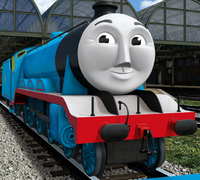

![George Hughes.png (2.29 MB) George Hughes[4]](https://static.wikia.nocookie.net/csydes-test/images/0/0a/George_Hughes.png/revision/latest/scale-to-width-down/200?cb=20170723020455)





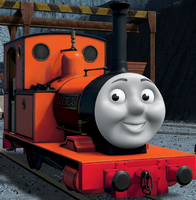









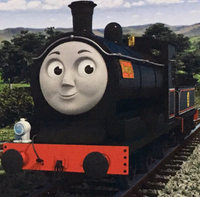





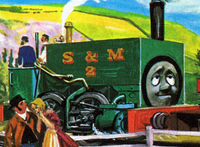





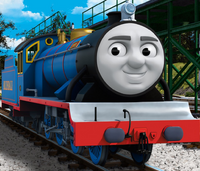













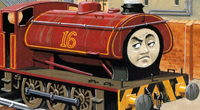









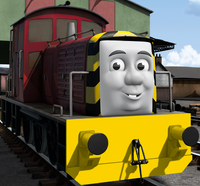









![Elliot.png (599 KB) Elliot[58]](https://static.wikia.nocookie.net/csydes-test/images/7/71/Elliot.png/revision/latest/scale-to-width-down/200?cb=20170427001842)






